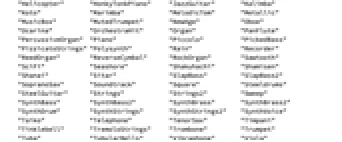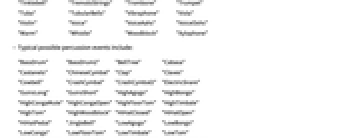SoundNote[pitch]
represents a music-like sound note with the specified pitch.
SoundNote[pitch,t]
takes the note to have duration t.
SoundNote[pitch,{tmin,tmax}]
takes the note to occupy the time interval tmin to tmax.
SoundNote[pitch,tspec,"style"]
takes the note to be in the specified style.
SoundNote[pitch,tspec,"style",opts]
uses the specified rendering options for the note.


SoundNote
SoundNote[pitch]
represents a music-like sound note with the specified pitch.
SoundNote[pitch,t]
takes the note to have duration t.
SoundNote[pitch,{tmin,tmax}]
takes the note to occupy the time interval tmin to tmax.
SoundNote[pitch,tspec,"style"]
takes the note to be in the specified style.
SoundNote[pitch,tspec,"style",opts]
uses the specified rendering options for the note.
Details and Options





- The pitch specification can be as follows:
-
0 middle C n n semitones from middle C "C", "C#", "D", etc. notes in the middle C octave "Cm", "C#m", "Dm", etc. notes in the m octave ("C4" is middle C) {p1,p2,…} a chord containing pitches pi None silence (a musical rest) "percussion" a percussion event - The forms "C#", "C♯" (entered as \[Sharp]), and "CSharp" are all equivalent.
- "Cb", "C♭" (entered as \[Flat]), and "CFlat" are also equivalent.
- Negative numbers specify pitches below middle C.
- The C one octave above middle C can be specified as 12 or "C5".
- "C+4" is equivalent to "C4"; low notes can be specified as "C-1" etc.
- SoundNote[pitch,t] specifies a total duration t; the actual sound of the note may decay before time t has elapsed.
- SoundNote[pitch,tspec] normally is by default taken to be in a piano style.
- Style s between 1 and 128 represents General MIDI instrument s.
- Style {bank,patch,s} represents an instrument in the specified bank and patch.
- In Sound, {"style",SoundNote[…],…} can be used to specify that many notes should be taken to be in the given style.
- SoundNote[] by default represents middle C in piano style with duration 1 second.
- Typical possible styles include:
-
"Accordion" "Agogo" "AltoSax" "Applause" "Atmosphere" "Bagpipe" "Bandoneon" "Banjo" "BaritoneSax" "Bass" "BassAndLead" "Bassoon" "Bird" "BlownBottle" "Bowed" "BrassSection" "Breath" "Brightness" "BrightPiano" "Calliope" "Celesta" "Cello" "Charang" "Chiff" "Choir" "Clarinet" "Clavi" "Contrabass" "Crystal" "DrawbarOrgan" "Dulcimer" "Echoes" "ElectricBass" "ElectricGrandPiano" "ElectricGuitar" "ElectricPiano" "ElectricPiano2" "EnglishHorn" "Fiddle" "Fifths" "Flute" "FrenchHorn" "FretlessBass" "FretNoise" "Glockenspiel" "Goblins" "Guitar" "GuitarDistorted" "GuitarHarmonics" "GuitarMuted" "GuitarOverdriven" "Gunshot" "Halo" "Harmonica" "Harp" "Harpsichord" "Helicopter" "HonkyTonkPiano" "JazzGuitar" "Kalimba" "Koto" "Marimba" "MelodicTom" "Metallic" "MusicBox" "MutedTrumpet" "NewAge" "Oboe" "Ocarina" "OrchestraHit" "Organ" "PanFlute" "PercussiveOrgan" "Piano" "Piccolo" "PickedBass" "PizzicatoStrings" "Polysynth" "Rain" "Recorder" "ReedOrgan" "ReverseCymbal" "RockOrgan" "Sawtooth" "SciFi" "Seashore" "Shakuhachi" "Shamisen" "Shanai" "Sitar" "SlapBass" "SlapBass2" "SopranoSax" "Soundtrack" "Square" "Steeldrums" "SteelGuitar" "Strings" "Strings2" "Sweep" "SynthBass" "SynthBass2" "SynthBrass" "SynthBrass2" "SynthDrum" "SynthStrings" "SynthStrings2" "SynthVoice" "Taiko" "Telephone" "TenorSax" "Timpani" "Tinklebell" "TremoloStrings" "Trombone" "Trumpet" "Tuba" "TubularBells" "Vibraphone" "Viola" "Violin" "Voice" "VoiceAahs" "VoiceOohs" "Warm" "Whistle" "Woodblock" "Xylophone" - Typical possible percussion events include:
-
"BassDrum" "BassDrum2" "BellTree" "Cabasa" "Castanets" "ChineseCymbal" "Clap" "Claves" "Cowbell" "CrashCymbal" "CrashCymbal2" "ElectricSnare" "GuiroLong" "GuiroShort" "HighAgogo" "HighBongo" "HighCongaMute" "HighCongaOpen" "HighFloorTom" "HighTimbale" "HighTom" "HighWoodblock" "HiHatClosed" "HiHatOpen" "HiHatPedal" "JingleBell" "LowAgogo" "LowBongo" "LowConga" "LowFloorTom" "LowTimbale" "LowTom" "LowWoodblock" "Maracas" "MetronomeBell" "MetronomeClick" "MidTom" "MidTom2" "MuteCuica" "MuteSurdo" "MuteTriangle" "OpenCuica" "OpenSurdo" "OpenTriangle" "RideBell" "RideCymbal" "RideCymbal2" "ScratchPull" "ScratchPush" "Shaker" "SideStick" "Slap" "Snare" "SplashCymbal" "SquareClick" "Sticks" "Tambourine" "Vibraslap" "WhistleLong" "WhistleShort" - The option SoundVolume->v specifies a relative sound volume v for a note.
- What notes can actually play as sounds may depend on the setup of your computer system.
- The computable list of instruments is available in .
Examples
open all close allBasic Examples (5)
Scope (16)
Basic Notes and Chords (6)
Timing (3)
Applications (8)
Play a chromatic scale starting at middle C:
Play a scale on a violin, with each note taking 0.1 seconds:
Play the first 20 primes as notes in woodblock style:
Play the first notes in Beethoven's Fifth Symphony:
Play a sequence of five notes on a synthesizer:
Generate a sequence of random notes:
Properties & Relations (2)
Possible Issues (2)
See Also
Sound SampledSoundList SampledSoundFunction Audio Beep EmitSound
Function Repository: MusicalScaleSample
Tech Notes
Related Guides
Related Links
History
Text
Wolfram Research (2007), SoundNote, Wolfram Language function, https://reference.wolfram.com/language/ref/SoundNote.html.
CMS
Wolfram Language. 2007. "SoundNote." Wolfram Language & System Documentation Center. Wolfram Research. https://reference.wolfram.com/language/ref/SoundNote.html.
APA
Wolfram Language. (2007). SoundNote. Wolfram Language & System Documentation Center. Retrieved from https://reference.wolfram.com/language/ref/SoundNote.html
BibTeX
@misc{reference.wolfram_2025_soundnote, author="Wolfram Research", title="{SoundNote}", year="2007", howpublished="\url{https://reference.wolfram.com/language/ref/SoundNote.html}", note=[Accessed: 14-December-2025]}
BibLaTeX
@online{reference.wolfram_2025_soundnote, organization={Wolfram Research}, title={SoundNote}, year={2007}, url={https://reference.wolfram.com/language/ref/SoundNote.html}, note=[Accessed: 14-December-2025]}